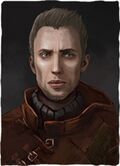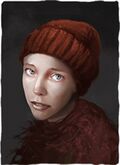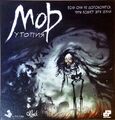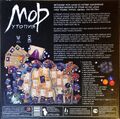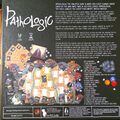Pathologic Tabletop
Developer(s) |
CapsLock Games Ice-Pick Lodge |
Publisher(s) |
Ice Pick Lodge Fabrika Igr (Фабрика Игр) |
Designer(s) |
Fuad "Funt" Kuliev Andrey "Lenoran" Salik Liu Sukhinina Elena "Joker" Vishina |
Platform(s) |
Tabletop |
Release |
2017 |
Language(s) |
Pусский (Russian) English |
Genre |
Tabletop, strategy, role-playing |
Mode(s) |
Multi-player (2-4 players) |
Pathologic Tabletop was originally a reward for $80 and higher tiers of the Pathologic 2 Kickstarter campaign; after its release, it was sold separately. Its gameplay and mechanics were developed by CapsLock Games in conjunction with Ice-Pick Lodge.
Plot
| “ | After the Ern experiment failure, the Bureau sent me to the Gorkhon under special orders. The goal: to stop the epidemic that had broken out in a small town of cattle herders. Status four, a potential pandemic. Mortality rate: 70%. They even set a deadline, it all had to be done in five days. A death sentence, that’s what it was. On arrival I followed standard procedure, declaring my absolute emergency powers. Hasty interrogations revealed that the whole town was supported by a few key figures. The joints of the machine. These people had to be preserved at any cost. Next, a sudden stroke of luck. Three healers turned out to have been in town since the very beginning of the outbreak, each offering their own serviceable solution to the issue. No elaborate data on their personas, I’m afraid. Just the basics. Daniil Dankovsky, a Bachelor of Medicine. A thanatologist from the Capital. He studies death. A rational, logical thinker. He offered an eccentric theory that had to do with soil contamination. Convenient. Artemy Burakh, a local man. He had gone away to study medicine, came back later. An intriguing theory based on blood and its circulation —his approach was rooted in the local tradition of the steppe people. Then there was a random beggar called Clara. She expressed obvious pathologic conditions (bioenergetic manipulation, extrasensory powers). I didn’t take her seriously at first, but rectified my mistake quickly. All in all, each of them offered compelling arguments. I had the luxury of choice. And the Town —the Town had a chance to survive.” |
„ |
| — From the statement of Aglaya Lilich, state inquisitor, received under interrogation (IV‑2.2) |
The plot of the tabletop game is a simplified version of the videogame. An odd town on the Steppe has been stuck by a sudden plague. Luckily, three healers have just arrived there in time to fight the disease: the Bachelor, the Haruspex and the Changeling.[1] The Tabletop board bases its Town design on Pathologic, placing the districts in similar locations.
Pieces
Items:
- 1 Game Rulebook
- 1 Town Map
- 4 Character sheets (three for the Healers, one for the Plague)
- 4 Quick Reference sheets (three for the Healers, one for the Plague)
- 3 Healer pieces
- 9 Ward pieces
- 12 black and 12 white piece stands
- 9 Obituary cards
- 1 Blockade token
- 3 Pact tokens
- 24 Plague Strains
- 3 Ticker tokens
- 1 Plague's Notebook
- 15 Event cards
- 10 Bachelor Prescription cards
- 10 Haruspex Prescription cards
- 10 Changeling Prescription cards
- 45 Resource counters (15 of each type)
Gameplay
General Gameplay
The game is meant for 2–4 players. An average session lasts one hour. Each player takes on the role of one of the three Healers or the Plague, each of which have their own play style. The Healers attempt to preserve their Entwined (Wards) while moving through the Town, while the Plague attempts to kill certain Entwined (Wards) and moves invisibly.[2]
The Bachelor player begins the game by placing either their Healer Card or one of their Ward Card's onto the Town Map in a district of their choice. The Haruspex and Changeling then do the same and the process repeats until all 12 pieces (Healer Cards and Ward Cards) are on the Town Map. A Healer or Ward Card cannot be placed in the same district as another one of the cards and as such by the end of this process 12 out of 15 of the districts should contain a Healer or Ward card.
Events are placed around the board that the Healers may either use their Ward, another Healer's Ward, or themselves to complete. A player will collect more evidence when using one of their own Wards to do so. Cards may only complete events if they are not under quarantine - a process that makes the card vulnerable to being taken out by the Plague player. All cards begin in quarantine. The status of a card is denoted by a black piece (quarantined) or a white piece (not quarantined). Whenever a Ward dies, the Healer responsible for them loses one piece of Evidence regardless of which Healer moved the card.
The turn order is Plague, Bachelor, Haruspex and then finally Changeling. In a three player game the Changeling is not played, and in a two player game only the Plague and the Bachelor is played.
For a Healer to win they must collect 8 pieces of evidence. A win for a Healer only applies to that Healer. Healers do not work as a team and, depending on the Players involved, may even actively work against each other. For the Plague to win they must kill the three specific Ward Cards they placed in their Obituary at the start of the game.
Bachelor Player
| “ | The Bachelor’s starting resource, a Coin, doesn’t necessarily stand for wealth, but rather authority: the local powers that be respect the big-city celebrity and eagerly take orders from him. He can enforce quarantine measures, limit the movement of other characters, and otherwise influence the social processes in the town. | „ |
| — Play style of the Bachelor |
The Bachelor excels in control. His deck is focused around preventing and controlling the placement of Wards, and restricting movement through districts. He is represented on the board by the image of a Vial. His initial resource is a Coin.
Haruspex Player
| “ | The Haruspex’s starting resource, a Secret, highlights the fact that he is privy to the mysteries impenetrable to others. As a local, he always knows which shortcut to take and how to obtain water. The Haruspex would rarely find himself empty-handed — finding resources is his strong suit. | „ |
| — Play style of the Haruspex |
The Haruspex excels in resource management. His Prescription deck is focused around actions without resource penalties. He is represented on the board by the image of a Kidney. His initial resource is a Secret.
Changeling Player
| “ | The Changeling starts with a Key since she unlocks hearts and doors with equal ease. Clara can change a person’s fate — for example, shielding them from the Plague, which she sometimes can control. However, the Changeling uses her talents to different ends, often focusing on hindering other Healers first and foremost. |
„ |
| — Play style of the Changeling |
The Changeling excels in protection. Her deck is focused around preventing the death of Wards and manipulating the Wards of the other Healers. She is represented on the board by the image of a Palm. Her initial resource is a Key.
Plague Player
| “ | The Plague acts very much unlike other characters: invisible and lethal, it is also slower. Instead of healing, it kills. And whenever there is doubt (say, a game ends in a draw), it wins. But no matter how competitive the Bachelor, the Haruspex, and the Changeling get, the Plague is their common arch-nemesis, so if you step in its shoes, be prepared to stand alone against the sometimes united force of other players. |
„ |
| — Play style of the Plague |
The Plague's goal is to infect and kill the Ward's of the Healers before any of the three Healers can collect enough Evidence against them. The Plague moves secretly through districts by transcribing their movements on a notepad provided in the items. The Plague is able to move through districts one at a time and may even move to the Steppe. To remove Ward Cards the Plague must announce where they are by saying that the district is infected when it is their turn. Once a district becomes infected the Plague player will force any Healer Cards into quarantine and kill any vulnerable Ward Cards. Should the Plague player kill a Ward card they are then able to take an extra movement turn and move to a new district. This can only occur once. The Plague is able to kill quarantined Ward Cards by Blockading districts. This takes at least two turns and the Plague is unable to move for the duration.
The Plague has access to Strain cards which they may place face-down in districts. Strain cards are trap cards that are activated the moment an unwitting Ward or Healer card performs an action nearby.
Gallery
Bachelor's First Edition player card
Haruspex's First Edition player card
Changeling's First Edition player card
Sand Plague's First Edition player card
Haruspex's Tabletop card portrait
Bachelor's Tabletop card portrait
Changeling's Tabletop card portrait
Andrey Stamatin's Tabletop card portrait
Vlad the Younger's Tabletop card
Capella's Tabletop card portrait
Taya Tycheek's Tabletop card portrait
Sticky's Tabletop card
Notkin's Tabletop card portrait
Alexander Saburov's Tabletop card portrait
Stanislav Rubin's Tabletop card portrait
Bad Grief's Tabletop card
Aspity's Tabletop card
The Abattoir in the Pathologic Tabletop Game
Official Videos
Notes
- In the First Edition of the Tabletop Game the Bachelor was represented by his Plaguefinder instead of a Vial.
References
| ||||||||



